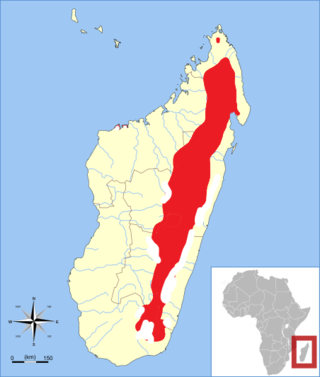
The mistletoe tyrannulet a very small passerine bird in the family Tyrannidae, the tyrant flycatchers. It is found from Guatemala and Belize to Colombia.

The tetrakas, also known as the Malagasy warblers, are a recently validated family of songbirds. They were formally named Bernieridae in 2010. The family currently consists of eleven species of small forest birds. These birds are all endemic to Madagascar.

Appert's tetraka formerly known as Appert's greenbul is a small passerine bird endemic to the south-west of Madagascar. The species was only described in 1972, and has been the subject of considerable taxonomic confusion. It was initially placed in the greenbul genus Phyllastrephus, and later with the Old World warblers in the genus Bernieria. Recent research indicates it is part of an endemic Malagasy radiation currently known as the Malagasy warblers.

The grey-crowned tetraka, formerly known as the grey-crowned greenbul, is a species of Malagasy warbler in the family Bernieridae. It is found only in eastern and northern Madagascar.

The long-billed bernieria, formerly known as long-billed greenbul and sometimes as common tetraka or long-billed tetraka, is a songbird species endemic to Madagascar. It is the only species placed in the genus Bernieria. Its natural habitat is subtropical or tropical moist lowland forests.

The Madagascan yellowbrow, also known as the yellow-browed oxylabes, is a species of Malagasy warbler, formerly placed in the family Sylviidae. Found only in Madagascar, it is the sole member of the genus Crossleyia. Its natural habitat is subtropical or tropical moist montane forests. It is threatened by habitat loss.

The white-throated oxylabes is a species of passerine bird that is endemic to Madagascar. It is the only species placed in the genus Oxylabes. Formerly considered as a member of the Old World warbler family Sylviidae, it has been moved to the family Bernieridae — the Malagasy warblers. Its natural habitat is subtropical or tropical moist lowland forests.

The grey-backed hawk is an Endangered species of bird of prey in subfamily Accipitrinae, the "true" hawks, of family Accipitridae. It is found in Ecuador and far northern Peru.
Meek's lorikeet is a species of parrot in the family Psittaculidae. It is found on Bougainville Island in Papua New Guinea and the Solomon Islands. Its natural habitats are subtropical or tropical moist lowland forest and subtropical or tropical moist montane forest. It is threatened by habitat loss.

The dusky gerygone is a species of bird in the family Acanthizidae. It is endemic to coastal central and northern areas of Western Australia.

The Serra do Mar bristle tyrant is a small species of bird in the tyrant flycatcher family Tyrannidae. It was formerly placed in the genus Phylloscartes and known in English as the Serra do Mar tyrannulet. It is endemic to humid montane forest in the Serra do Mar in south-eastern Brazil. More likely confused with the short-tailed and pale-eyed hangnest tody-tyrant, its bright olive-green upperparts contrast strongly with the grey underparts. It is generally uncommon and threatened by habitat loss.

The São Paulo bristle tyrant is a species of bird in the tyrant flycatcher family Tyrannidae. It was formerly placed in the genus Phylloscartes and known in English as the São Paulo tyrannulet. It is found in the southern Atlantic Forest region of South America. Its natural habitats are subtropical or tropical moist lowland forest and subtropical or tropical moist montane forest. It is threatened by habitat loss.

The speckled antshrike or spiny-faced antshrike is a Near Threatened species of bird in subfamily Thamnophilinae of family Thamnophilidae, the "typical antbirds". It is found in Colombia and Panama.

The spotted woodcreeper is a species of bird in the subfamily Dendrocolaptinae of the ovenbird family Furnariidae. It is found in Belize, Colombia, Costa Rica, Ecuador, El Salvador, Guatemala, Honduras, Mexico, Nicaragua, and Panama.

The Venezuelan tyrannulet is a species of passerine bird in the family Tyrannidae, the tyrant flycatchers. It is endemic to Venezuela.

The grey-crowned woodpecker is a species of bird in subfamily Picinae of the woodpecker family Picidae. It is endemic to western Mexico.

Zahamena National Park is a national park of Madagascar. Established in 1997, it covers an area of 423 square kilometres (163.32 sq mi) out of a total protected area of 643 square kilometres (248.26 sq mi). It is part of a UNESCO World Heritage Site, Rainforests of the Atsinanana, inscribed in 2007 and consisting of 13 specific areas located within eight national parks in the eastern part of Madagascar. In 2001, Bird Life International assessed avifauna of 112 species of which 67 species are exclusively endemic to Madagascar.
Kalambatritra Special Reserve is a wildlife reserve in southern Madagascar. It is to the north of Andohahela National Park, south-west of the Manombo Special Reserve and contains many endemic species, including forty-five endemic bird species.

The Chilean elaenia is a species of bird in subfamily Elaeniinae of family Tyrannidae, the tyrant flycatchers. It is found in Argentina, Bolivia, Brazil, Chile, Colombia, Paraguay, Peru, and Uruguay.

The Ampay tapaculo is a species of bird in the family Rhinocryptidae. It is endemic to Peru.


















